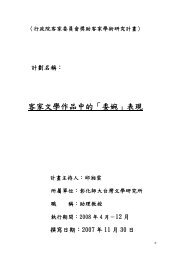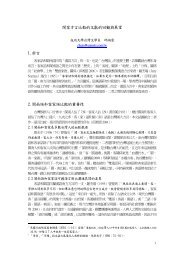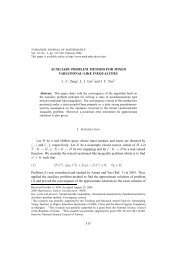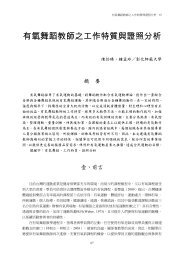客、閩、華語三字熟語隱喻造詞類型表現 - 國立彰化師範大學
客、閩、華語三字熟語隱喻造詞類型表現 - 國立彰化師範大學
客、閩、華語三字熟語隱喻造詞類型表現 - 國立彰化師範大學
- No tags were found...
You also want an ePaper? Increase the reach of your titles
YUMPU automatically turns print PDFs into web optimized ePapers that Google loves.
272 彰 化 師 大 國 文 學 誌 第 二 十 二 期Three-syllable idioms metaphorperformance types of Hakka,Taiwanese and MandarinChiu, Hsiang-Yun( 邱 湘 雲 )"Metaphor" is a major driving force for the development of Chinese vocabulary.Many of the idioms formed by the way of metaphor.Different languages use differentmethods to create new words.Cognitive linguists Lakoff & Johnson(1980, 2006)haspointed out: most of the concepts in people's lives are essentially expressed bymetaphor. Metaphor can be divided into: orientation metaphor, ontological metaphorsand structural metaphors, take different metaphor reflects the ethnic differences onthinking and cultural.This article will focus on Hakka, Taiwanese and Mandarinthree-syllable idioms, from a cognitive point of view to explore the formation ofmetaphor, metaphor types, and cultural characteristics exhibited in vocabulary. This articlepoints out: We can combine the "structuralism", "cognitive linguistics"and"prototypetheory"and other semantic theory to explore the metaphorical context of the formationof idioms.Metaphorical idioms also reflect the ethnic way of thinking.In the concept ofmetaphor in idioms, we can observe the different linguistic groups cognitive model andto further learn about the knowledge content and cultural performance in differentethnic groups.Keywords: Three-syllable idioms;metaphor;Hakka;Taiwanese;Mandarin- 272 -
















